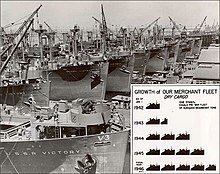Adjusted Service Rating Score

The Adjusted Service Rating Score was the system that the United States Army used at the end of World War II in Europe to determine which soldiers were eligible to be repatriated to the United States for discharge from military service as part of Operation Magic Carpet.
History[]
As the end of the war in Europe became a reality, the US War Department began planning for the redeployment of Army personnel following the end of hostilities. The Readjustment Regulations were first introduced on September 15, 1944, and revised February 15, 1945, and again on March 5, 1945.
The rules were simple in general principle: "those who had fought longest and hardest should be returned home for discharge first." The US Army divided units of the European Theater of Operations into four categories:
- Units designated as occupation forces (such as the Third and Seventh Army)
- Units that had been overseas for less than one year, or those: (a) to be redeployed directly to the Pacific; (b) to be redeployed to the Pacific via the United States; (c) to be returned to the United States to be placed in strategic reserve.
- Units to be organized or re-organized in the European Theater for use as occupation forces, or to be redeployed to the Pacific Theater of Operations.
- Units to be returned to the United States and inactivated or disbanded.
New troops would be deployed to Europe as replacements for the veterans returning home.
Initial criteria[]
An enlisted man needed a score of eighty-five points to be considered for demobilization. The scores were determined as follows:[1]
- Month in service = 1 point each
- Month in service overseas = 1 point each, in addition to month in service
- Combat award (Medal of Honor, Distinguished Service Cross, Distinguished Service Medal, Legion of Merit, Silver Star Medal, Distinguished Flying Cross, Soldier's Medal, Bronze Star Medal, Air Medal, Purple Heart) or campaign participation star = 5 points each
- Dependent child under eighteen years old = 12 points each
Time of service was calculated from September 16, 1940.[2] The four criteria were the only ones from which points were calculated. No points were issued for age, marriage, or dependent children over the age of eighteen. Battles and awards were also only accepted from a predetermined list.[1]
Classes[]

Different scores were set for troops in the US Army, US Army Air Forces, Women’s Army Corps and holders of the Medal of Honor.
Officers[]
Before the surrender of Japan, officers who may have had to serve again in combat were assessed not only on their ASR score but also on their efficiency and military specialities. Most high-scoring officers could have expected an early discharge after VE Day. The qualifying score was revised down to eighty points after VJ Day. In the coming months it would be lowered again.[2]
Medical personnel[]
Scores varied before the end of May 1945 by varied department in the Medical Corps.
- Medical Administrative Corps (MAC) = 88 points
- Medical Corps (MC) = 85 points (plus specialty)
- Nurses Corps = 71 points
- Physical Therapists = 65 points
- Hygienists and Dietitians = 62 points
The discharge program continued until the end of July 1945; the demand to ship personnel and equipment to the Pacific became so great that medical units were prevented from shipping back to the United States for inactivation. However, all transfers to the Pacific were abruptly halted with announcement of the Japanese surrender on August 14, 1945.[3]
Post-war changes[]
By September 1945, the War Department redesignated all units in Europe as either Occupation Forces (personnel with either the lowest scores or who were volunteers), Redeployment Forces (those with the highest score being sent back to the United States) or Liquidation Forces (troops with middle scores of 60–79 points) who were required to close down former front line facilities such as munition dumps or field hospitals.
Nevertheless, the ASR began to create problems for the US Army in post-war Germany as high-scoring personnel plus the attrition caused by sickness, compassionate leave and accidents meant continual loss of many experienced officers and NCOs.
By December 1, 1945, a new policy was started, which was based on a combination of ASR score and length of service. The points required were as follows:
- Officers (excluding Medical Department & WAC) = 70 and four years of military service
- Women's Army Corps officers = 37 points
- Medical Department officers = 55 points
- All enlisted men = 50 and four years of military service
- All enlisted women = 32 points
All enlisted fathers with three or more dependent children under 18 years of age were immediately eligible for discharge irrespective of their time in military service.[1]
See also[]
- End of World War II in Europe
- Allied-occupied Germany
- Post–World War II demobilization strikes
- Aftermath of World War II
- Demobilization of the British Armed Forces after World War II
- Demobilization of United States armed forces after World War II
References[]
- ^ a b c "Explanation of the ASR Points System from Stars and Stripes". Stars and Stripes. Archived from the original on 2011-06-17. Retrieved 2010-04-21.
- ^ a b "Points System". MILITARY OCCUPATIONAL SPECIALTY. Retrieved 2010-04-21.
- ^ "The Medical Administrative Corps". US Army Medical Department. Retrieved 2010-05-03.
- United States Army in World War II
